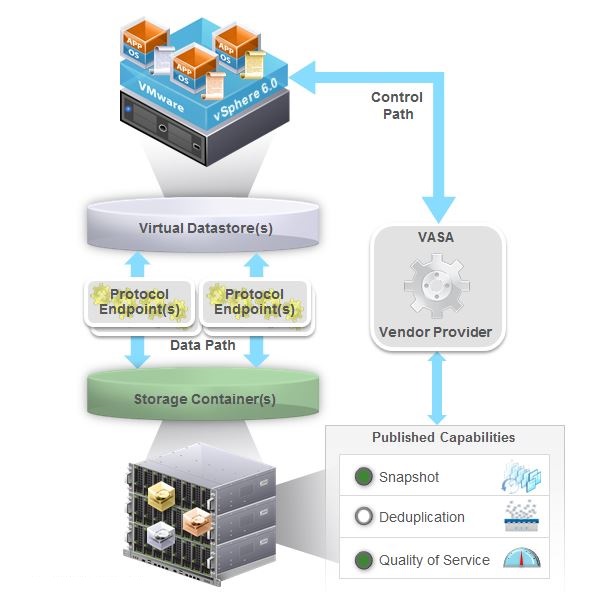https://kb.vmware.com/selfservice/microsites/search.do?language=en_US&cmd=displayKC&externalId=2113013
Summary
Virtual Volumes (VVols) is a new integration and management framework that virtualizes SAN/NAS arrays, enabling a more efficient operational model that is optimized for virtualized environments and centered on the application instead of the infrastructure. Virtual Volumes simplifies operations through policy-driven automation that enables more agile storage consumption for virtual machines and dynamic adjustments in real time, when they are needed. It simplifies the delivery of storage service levels to individual applications by providing finer control of hardware resources and native array-based data services that can be instantiated with virtual machine granularity.
With Virtual Volumes (VVols), VMware offers a new paradigm in which an individual virtual machine and its disks, rather than a LUN, becomes a unit of storage management for a storage system.Virtual volumes encapsulate virtual disks and other virtual machine files, and natively store the files on the storage system.
Overview
Virtual Volumes (VVols) are VMDK granular storage entities exported by storage arrays. Virtual volumes are exported to the ESXi host through a small set of protocol end-points (PE). Protocol Endpoints are part of the physical storage fabric, and they establish a data path from virtual machines to their respective virtual volumes on demand. Storage systems enables data services on virtual volumes. The results of these data services are newer virtual volumes. Data services, configuration and management of virtual volume systems is exclusively done out-of-band with respect to the data path. Virtual volumes can be grouped into logical entities called storage containers (SC) for management purposes. The existence of storage containers is limited to the out-of-band management channel.
Virtual volumes (VVols) and Storage Containers (SC) form the virtual storage fabric. Protocol Endpoints (PE) are part of the physical storage fabric.
By using a special set of APIs called vSphere APIs for Storage Awareness (VASA), the storage system becomes aware of the virtual volumes and their associations with the relevant virtual machines. Through VASA, vSphere and the underlying storage system establishes a two-way out-of-band communication to perform data services and offload certain virtual machine operations to the storage system. For example, operations such as snapshots and clones can be offloaded.
For in-band communication with Virtual Volumes storage systems, vSphere continues to use standard SCSI and NFS protocols. This results in support with Virtual Volumes for any type of storage that includes iSCSI, Fibre Channel, Fibre Channel over Ethernet (FCoE), and NFS.
-
- Virtual Volumes represent virtual disks of a virtual machine as abstract objects identified by 128-bit GUID, managed entirely by Storage hardware.
- Model changes from managing space inside datastores to managing abstract storage objects handled by storage arrays.
- Storage hardware gains complete control over virtual disk content, layout and management.
Storage partners have already started adding VVols support in their arrays. For end-to-end VVols support, HBA drivers need to support VVols-based devices. This necessitates availability of an API to get the second-level LUN ID (SLLID) and use by the SCSI drivers.
Drivers that support I/O to VVols, needs to advertise second-level addressing capability in their driver at the time of adapter registration. In addition, the HBA drivers need to advertise its second-level (SLLID) addressing capability with the ESXi storage stack. For more information, see VMware ESXi 6.0 I/O driver information: certified 5.5 I/O drivers are compatible with vSphere 6.0 (2111492). This is required so that the ESXi host storage stack can take a decision if the adapter can handle VVols I/O.
When checking the I/O Devices section of the VMware Compatibility Guide, you will see a new entry called Secondary LUNID. (Enables VVols). The ESXCLI infrastructure has the provision to display SSLID capability output of the HBA with this command esxcli storage core adapter list
